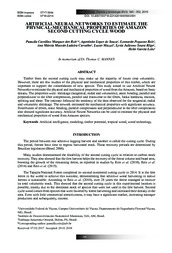Artificial neural networks to estimate the physical-mechanical properties of amazon second cutting cycle wood.
Artificial neural networks to estimate the physical-mechanical properties of amazon second cutting cycle wood.
Autoria: REIS, P. C. M. dos R.; SOUZA, A. L. de; REIS, L. P.; CARVALHO, A. M. M. L.; FREITAS, L. J. M. de; RÊGO, L. J. S.; LEITE, H. G.
Resumo: Timber from the second cutting cycle may make up the majority of future crop volumetric. However, there are few studies of the physical and mechanical properties of this timber, which are important to support the consolidation of new species. This study aimed to use Artificial Neural Networks to estimate the physical and mechanical properties of wood from the Amazon, based on basic density. The properties were: shrinkage (tangential, radial and volumetric), static bending, parallel and perpendicular to the fiber compression, parallel and transverse to the fibers, Janka hardness, traction, splitting and shear. The estimate followed the tendency of the data observed for the tangential, radial and volumetric shrinkage. The network estimated the mechanical properties with significant accuracy. Distribution of errors, static bending, parallel compression and perpendicular to the fiber compression also showed significant accuracy. Artificial Neural Networks can be used to estimate the physical and mechanical properties of wood from Amazon species.
Ano de publicação: 2018
Tipo de publicação: Artigo de periódico
Unidade: Embrapa Amazônia Oriental
Palavras-chave: Inteligência artificial, Madeira, Modelagem, Tecnologia
Observações
1 - Por padrão são exibidas publicações dos últimos 20 anos. Para encontrar publicações mais antigas, configure o filtro ano de publicação, colocando o ano a partir do qual você deseja encontrar publicações. O filtro está na coluna da esquerda na busca acima.
2 - Para ler algumas publicações da Embrapa (apenas as que estão em formato ePub), é necessário ter, no celular ou computador, um desses softwares gratuitos. Sistemas Android: Google Play Livros; IOS: iBooks; Windows e Linux: software Calibre.
Acesse outras publicações
Acesse a Base de Dados da Pesquisa Agropecuária (BDPA) para consultar o acervo completo das bibliotecas da Embrapa.

